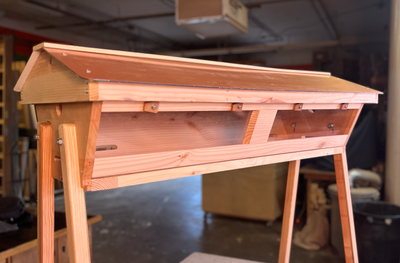5 Simple Steps to Keeping Mason Bees
5 Simple Steps to Keeping Mason Bees
By Taryn Murphy
When most people think of beekeeping, they often think of our delightful, hive-loving friends: honeybees. While honeybees are notoriously fascinating and invaluable, there are over 20,000 more species of bees, each serving incredible functions and showcasing different talents.
Some of our favorite pollinators are mason bees, a solitary native species that are 1,900 times better at pollinating than honeybees and rarely sting, if ever. Mason bees nest in tubes or holes instead of hives, making them easy to care for and nifty friends to keep around. Plus, you don’t need any fancy gear to raise them. Just get your hands on a few simple materials and you’re ready to go!
Interested in keeping mason bees? Here are the 5 simple steps we recommend to be successful.
1. Source healthy mason bees
You can buy mason bee cocoons or attract local bees: your choice! When purchasing bees, we trust our friends at Crown Bees in Woodinville, Washington for high-quality cocoons. But remember to buy soon as most mason bee providers run out of stock quickly!
If you’d like to attract local bees yourself, it’s surprisingly simple. Set out some nesting tubes within an enclosure that keeps them dry and safe. Make sure they’re near a variety of flowers and plants with a moist, clay-rich mud source available. If you craft an inviting nesting place with the right amenities, mason bees are likely to come.
2. Scout out the flora and fauna
Check your garden, backyard, or orchard to ensure that your bees have plenty of forage and nesting materials within a 300 foot radius of their nesting area. Mason bees gather nectar and pollen from many kinds of flowers, so they appreciate variety when foraging.
When adding bee forage to your habitat, keep in mind that the best plants are native plants. Do your best to avoid hybrid plants which provide less nectar and pollen for your bees. We also recommend plants with staggered blooming periods, which allow mason bees to forage for as long as possible during the season.
Not sure what plants are best? Check out the Xerces Society, which offers helpful information on the best plants for native bees.
3. Set up your bee house
Whether you’re setting up your bee habitat to attract bees or to accommodate the bees you’ve already purchased, choose a sturdy bee house with ample room for cocoon release and protection.
There are many sizes and designs to choose from. Some of our favorites are the Chalet Bee House and Mason Bee House Square.
Once you’ve acquired your house, mount it to a solid object or foundation like a wall, fence, or other wind-broken space. The best height is eye-level (about 5 feet). Make sure it’s south to southeast facing, as bees are ectothermic (deriving their warmth from the surroundings) and need the morning sun. Lastly, remember to place it within 300 feet of blooms and gardens.
4. Get your timing right
When the daytime temperatures in your area begin to reach a consistent 55° F and flowers begin to bloom, it’s time to release your cocoons!
We recommend releasing them on top of or behind your nesting tubes in two waves. Release the first half when optimal temperatures are reached, and the second two weeks later. This gives you a buffer in case one wave doesn’t thrive as well, and extends your spring pollination season. You can store your second wave of cocoons in the refrigerator until you are ready to release them.
5. Harvest your cocoons
Mason bee season usually comes to a close by early summer when the tunnels of your nesting tubes are capped with mud. Collect your nesting reeds or tubes and place them in a protective, breathable bag with the capped ends facing up. Make sure to store them in a warm location until fall cocoon harvest.
You can also leave your tubes in their bee house until fall, but your cocoons will be more susceptible to parasites and disease.
Once fall arrives, crack or split open your tubes and sort out the light grey, oblong cocoons from the nesting debris. Do so in a cool environment to ensure that your bees don’t wake up early.
If the cocoons seem to be covered in mites (resembling sawdust), place them in a bath of room temperature water with a drop of bleach for 50 seconds or less. Discard any cocoons which don’t float, as well as any c-shaped cocoons (which indicate a fungal spore disease called chalkbrood).
Gently dry your cocoons and store them in a breathable container (we recommend a paper bag or cardboard box) in your refrigerator over winter. Feel free to add a damp paper towel for moisture every few weeks so the cocoons don’t dry out. The ideal environment is 30-40° F at 60-70% humidity.
Once spring arrives, place your cocoons in some fresh nesting tubes in your mason bee house. Congrats, you’ve done it!
For more information and education about mason bees, watch this short video.





